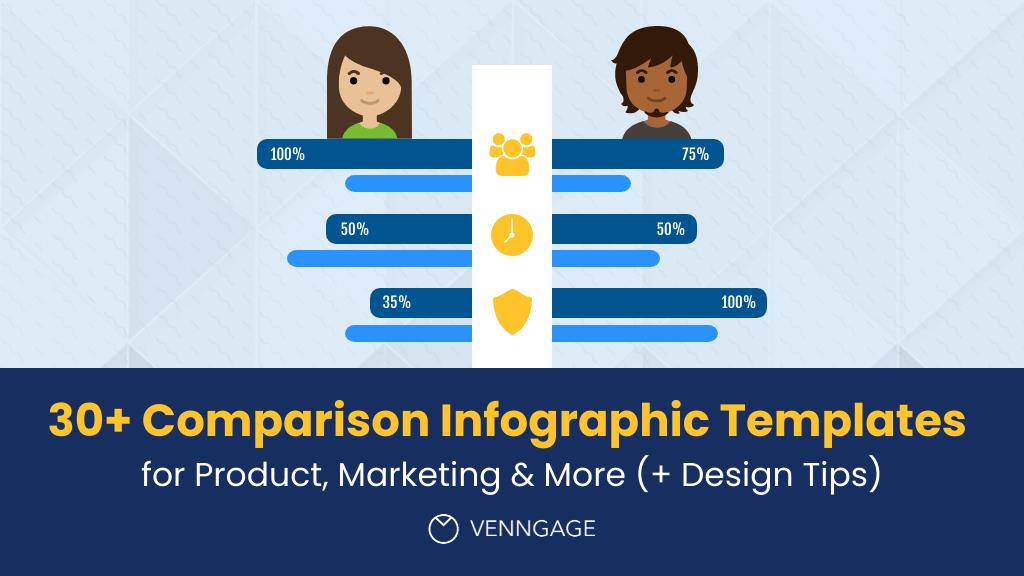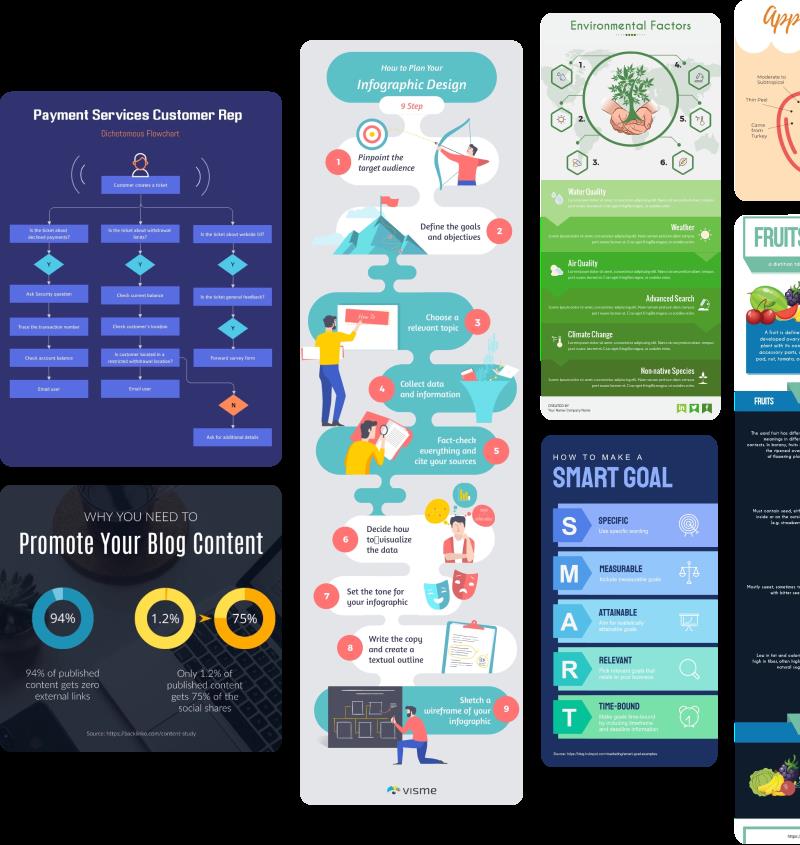
In today's hyper-competitive business landscape, effective brand remembrance is crucial. Infographics, when designed strategically, can significantly enhance brand recall.
This article explores eight ingenious methods to leverage infographics for lasting brand remembrance. These methods include aspects like data visualization, logo placement, color psychology, storytelling, interactivity, brand messaging, consistency, and typography.
Learn how to innovatively use these elements to ensure your brand remains etched in the minds of your audience.
Harnessing the Power of Data Visualization in Infographics
One must not underestimate the potential of data visualization when it comes to creating impactful infographics that can significantly enhance brand remembrance. Visualizing complex data in an engaging, digestible manner is an art form, and it's this combination of creativity and analytics that sets superior infographics apart.
The aesthetics of an infographic are crucial in determining its effectiveness. A well-designed infographic not only simplifies complex information but also captivates the audience, fostering stronger brand recall. By strategically marrying data with design, one can craft compelling narratives that resonate with audiences and strengthen brand associations.
Hence, understanding and employing effective data visualization techniques in infographics is a powerful tool for brands seeking to innovate and leave a lasting impression.
The Art of Effective Logo Placement in Infographics
In the realm of infographics, effective logo placement is not only an art but also a strategic maneuver that can significantly enhance brand remembrance. This approach, deeply rooted in understanding Logo Evolution and diverse Infographic Styles, is key to crafting compelling visuals that resonate with your target audience.

Logo at the Top: A logo placed at the top establishes brand presence, ensuring it's the first image viewers see.
Repeated Logo: A repeated logo subtly reinforces brand identity throughout the infographic.
Logo Within Data Visualizations: Incorporating the logo within data visualizations adds a creative touch.
Logo at the Bottom: A logo at the bottom serves as a memorable sign-off.
This strategic placement, combined with continual logo evolution, can elevate infographics and catalyze brand remembrance.
Utilizing Color Psychology for Brand Remembrance
Understanding the fundamental principles of color psychology can significantly enhance brand remembrance. The strategic selection and application of colors in branding, specifically in infographics, can evoke emotions and associations that latch onto the consumer's memory.
Therefore, we will explore the role of specific colors in building brand identity, and the potency of color combinations in creating impactful and memorable visual content.

Color Psychology Basics
Through the study of color psychology, businesses can strategically utilize specific hues to enhance brand remembrance and engagement. The impact of color symbolism on perception cannot be overstated.
Red often denotes energy, passion, and urgency, making it excellent for call-to-action buttons.
Blue conveys trust and stability, ideal for industries like finance and healthcare.
Yellow, the color of optimism and creativity, can stimulate mental processes and encourage communication.
Green symbolizes health, tranquility, and nature, often used by environmentally conscious brands.
In orchestrating a brand's visual identity, understanding the psychological implications of color is paramount. It's not simply about aesthetic appeal; it's a strategic opportunity to evoke desired emotional responses and ultimately, enhance brand remembrance.
Colors and Brand Identity
With the right blend of colors and strategic placement, brands can harness the power of color psychology to leave a lasting impression on their audience. An understanding of color trends and their psychological associations can guide the creation of a brand personality that resonates with the target demographic.

The selected colors reflect the brand's values and purpose, subtly conveying messages that form the basis of consumer perception. It's not just about being visually appealing, but strategically aligning color palettes with the brand's intentions.
This exploit of color trends and psychology fosters brand remembrance, influencing consumer behavior in favor of the brand. Innovation in color selection and placement can thus be a game-changer, cementing the brand identity in the consumer's mind.
Effective Color Combinations
Almost all successful brands employ strategic color combinations, and the careful utilization of color psychology, to enhance their brand remembrance and distinguish themselves from competitors. This is because color schemes impact our perception and memory, leading to stronger brand recognition.
Red and Yellow: Symbolic connotations of excitement and optimism make this combination popular among fast food chains.
Blue and White: Associated with trust and cleanliness, it's preferred by medical and technology brands.
Green and Brown: Evokes feelings of nature and sustainability, resonating with eco-conscious consumers.
Black and Gold: Exudes luxury and exclusivity, effective for high-end brands.

Storytelling Through Infographics: A Powerful Memory Tool
Storytelling through infographics is undeniably a potent instrument for amplifying brand remembrance. By shaping information into compelling narratives, infographics can dramatically enhance the recall of complex data, making your brand more memorable.
Moreover, when these visual narratives are paired with emotional cues, a profound connection is formed with the audience, further cementing the brand in their memory.
Infographics as Narratives
Utilizing infographics as a narrative tool can significantly enhance the audience's memory retention and engagement with your brand. Employing narrative structures within infographic designs can boost your brand's visibility and recall.
Beginning: Start with a compelling introduction that hooks the audience and frames the narrative.
Middle: This is where the main content resides, use data visualization to tell your story and keep it engaging.
Climax: The most important point or the solution should be here, depicted with impactful visuals.
End: Conclude the story, summarizing the key points and placing your brand logo prominently for remembrance.

Crafting an infographic that tells a story is an innovative strategy. It not only conveys complex data in an understandable format but also reinforces your brand image in the audience's mind in a memorable manner.
Enhancing Recall With Graphics
The human brain's ability to process visual information and its preference for compelling narratives can be leveraged to enhance recall of your brand. Infographics serve as a powerful tool in this endeavor.
Leveraging graphic simplicity, infographics can distill complex data into digestible, visually appealing information, ensuring your brand's message is not lost in clutter.
Strategically, icon usage is a potent part of this process. Icons, as simplistic renderings of larger ideas, break down concepts into easily understood elements. They act as visual anchors, enhancing recall and strengthening the association between your brand and its messaging.
Creatively, infographics can weave a narrative around your brand, reinforcing its identity and values.
Thus, by combining graphic simplicity with strategic icon usage, infographics become a powerful tool for brand remembrance.
Emotional Connections via Infographics
We can further enhance brand remembrance by establishing emotional connections with the audience through storytelling in infographics. This method, known as infographic emotionality, uses emotion-driven design to create memorable experiences.

Story Arcs: Crafting a compelling story arc within infographics can evoke emotional responses, making the brand more memorable.
Visual Metaphors: Using symbolic visuals to represent emotions can subtly yet powerfully resonate with viewers.
Color Psychology: Colors can evoke specific emotions; harnessing this can enhance infographic emotionality.
Personalization: Tailoring content to resonate with individual experiences amplifies emotional connections.
Strategically integrating these elements within infographics can significantly boost brand remembrance. By leveraging the power of emotions, brands can forge deeper connections with their audience, ultimately driving engagement and loyalty.
Infographics and Interactive Elements: Engaging Your Audience
Integrating interactive elements into your infographics can significantly enhance audience engagement and boost brand remembrance. By understanding audience segmentation, you can tailor your infographics to resonate more deeply with each segment.
Infographic personalization, for instance, can be achieved by incorporating interactive elements that appeal to the unique interests and needs of each segment. This strategic approach not only increases user engagement but also fosters a sense of connection and relevance, thereby enhancing brand remembrance.

Furthermore, introducing elements of gamification or interactive storytelling can create a more memorable and engaging experience.
Thus, the integration of interactive elements, based on a deep understanding of your audience, is a creative and innovative approach to maximize the impact of your infographics.
How to Use Infographics for Effective Brand Messaging
Utilizing infographics for brand messaging involves an analytical, strategic, and creative approach. One must skillfully combine data visualization and narrative to create a compelling story. This involves using compelling visuals to simplify complex data, making it easily understandable and memorable. Weaving the brand's story into the infographic makes the brand message more relatable and engaging. Infographics should be created in a scalable way that can easily fit different channels without losing clarity or impact. Leveraging multiple platforms for infographic distribution maximizes reach and reinforces brand messaging. When properly executed, infographics can be a potent tool for effective brand messaging.
The Role of Consistency in Infographics for Brand Recognition
Maintaining consistency in your infographics not only reinforces brand recognition but also builds trust with your audience over time. The importance of consistency cannot be overstated. It serves as a strategic tool that subtly yet powerfully communicates your brand's identity, values, and promise.
Infographic repetition, which involves the regular use of consistent color schemes, typography, and style, helps in creating a visual imprint of your brand in the viewer's mind. This creative approach gradually fosters brand recall and loyalty.
It's crucial to note that inconsistency can dilute your brand's image and confuse your audience. Hence, when innovatively designing infographics, you must maintain a balance between creativity and consistency. This combination will ensure your infographics are not only engaging but also effective in driving brand recognition.
Innovative Typography in Infographics for Stronger Brand Impact
While it is important to maintain consistency in design elements, exploring innovative typography in infographics can significantly enhance the impact of your brand on the audience.

Typography trends: Staying updated with typography trends not only makes your infographic look modern, but also communicates that your brand is forward-thinking.
Font selection: Careful font selection can create a mood, evoke emotion, or even emphasize a crucial point.
Font pairing: Mixing fonts in a harmonious way can enrich visual interest while keeping the reader engaged.
Hierarchy and Scale: A strategic use of font sizes can guide the reader's eye through the infographic, establishing a visual hierarchy.
Frequently Asked Questions
Infographics can enhance social media marketing by leveraging current infographic design trends and user engagement strategies. These visually engaging tools can simplify complex data, increase brand visibility, and foster higher user interaction rates.
What Are Some Key Considerations When Choosing a Software to Create Infographics?
When selecting infographic software, key considerations should be software usability and design flexibility. A user-friendly interface, along with customizable templates and editing tools, will foster innovation and creativity in your infographic designs.
How Can Infographics Be Used in Email Marketing for Better Brand Recall?
Infographics can enhance email marketing by boosting brand recall. Utilizing infographic personalization can drive email engagement, presenting complex data visually and reinforcing brand identity with consistent logo and color scheme usage.

When creating an infographic for brand promotion, it's essential to adhere to Fair Use Principles and avoid Copyright Infringement. Ensure all data, images, and content used are either owned or properly licensed.
How Can Brands Measure the Impact or Success of Their Infographics?
Brands can utilize infographic analytics to measure user engagement. Metrics such as shares, likes, comments, and time spent can provide insights into the success and impact of their infographic-based branding strategies.
 Digital Art InstructionDIY Infographics DesignMobile Game ArtworkPersonalized Logo Design3D AnimationeBook Covers DesignPrivacy PolicyTerms And Conditions
Digital Art InstructionDIY Infographics DesignMobile Game ArtworkPersonalized Logo Design3D AnimationeBook Covers DesignPrivacy PolicyTerms And Conditions
